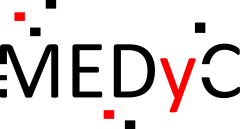
Faced with COVID-19, research is mobilizing in record time. Thus, the HT-Covid project led by Prof. Jean-Hugues Renault, director of the UMR ICMR (CNRS/URCA) was submitted at the end of March and selected by the ANR. The Modelling and Multi-scale Imaging team (MIME) of our unit is a partner in this project.
The objective of this project is to develop a very high throughput, original and integrated approach, based on molecular docking by direct and reverse screening for a rapid and efficient evaluation of different databases of very large chemical spaces on relevant drug targets of SARS CoV-2, in order to rapidly find small antiviral molecules as drug candidates.
Using the performance of current supercomputers - the computing power required for the simulation is notably made possible by the national infrastructures of the GENCI network, including the ROMEO supercomputer at URCA -, the idea is to test 1.5 billion molecules from virtual chemical spaces (the molecules are designed by artificial intelligence) or real ones (the molecules exist and can be natural or synthetic) to identify chemical structures that are likely to have antiviral activity against the SARS-CoV-2 virus (COVID-19).
"The originality of our "virtual" approach is to couple an ultra-large scale screening with the knowledge of the virus of biologists and physicians. Then we synthesize, purify and test potential candidates in the real world," explains Jean-Hugues Renault. This cross-referenced study of the results of the two approaches will make it possible to select five hundred candidates for the transition to the real world and the manufacture of molecules and their biological evaluation.
At present, more than a billion structures have already been tested and the time has come to analyze the colossal amount of data. Methodological developments have also been carried out and have made it possible, among other things, to make the process of automating calculations more reliable and to reduce calculation times considerably (by a factor of more than 100!).
In order to find potential molecules with an activity on the SARS-CoV-2 virus, the project relies on a network of chemists, biophysicists, biologists, computer scientists and physicians, which has been structured in record time due to the health context.
This transdisciplinary network includes: three CNRS academic partners in chemistry and chemoinformatics (ICMR - UMR 7312 - University of Reims Champagne-Ardenne / UMR 7200 - University of Strasbourg / UMR 6230 - University of Nantes), one CNRS academic partner in biophysics-modeling (MEDyC - UMR 7369, University of Reims Champagne-Ardenne), an academic partner specialized in human virology (CardioVir - EA 4684, University of Reims Champagne-Ardenne), an infectious diseases hospital service in the Grand Est region (CHU Reims), and an academic partner in the field of computer science (CReSTIC - EA 3804, University of Reims Champagne-Ardenne). This project also involves some of the main French computing centers (CC- IN2P3, GENCI, ROMEO HP Center, and probably in the future the Jean Zay supercomputer and the CEPP - Center for Excellence in Parallel Programming - Atos) allowing access to more than 150,000 processors and a data storage of the order of 2 Po ; the ChemBioFrance national research infrastructure, which provides access to the national chemical library; the AD2P high-throughput screening platform (IBISA, Marseille), which is already operational for SARS-CoV targets; and the Chem-Symbiosis platform (IBISA, Nantes), which is used to synthesize drug candidates.
The data produced by the HT-Covid project will be freely available.
This project is funded by the CNRS and the Grand Est region.

